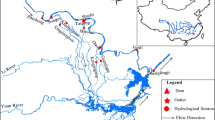Abstract
By using field-survey hydrological data of the related control stations in Dongting Lake and the Yangtze River mainstream in 1951–2010, the evolution characters of water exchange abilities between the two water bodies and their response to the operation of the Three Gorges Reservoir (TGR) from different time scales are analyzed based on their hydraulic relations. The results are shown as follows. Firstly, during July-September, the replenishment ability of Three Outlets to Dongting Lake is stronger, and in January-March, the replenishment ability of Dongting Lake to Yangtze River is stronger. Secondly, there has been an obvious inter-decadal wave on the water exchange coefficient between Dongting Lake and Yangtze River. In 1951–1958 and 1959–1968, the replenishment ability of Three Outlets to Dongting Lake was stronger, but in 2003–2010, the replenishment ability of Dongting Lake to Yangtze River has been strengthened. Thirdly, the spill-division ability of Three Outlets weakens, and the water of Dongting Lake coming from Three Outlets decreases either in typical years or under different dispatching modes of the TGR after the operation of the Three Gorges Reservoir. Furthermore, the water of Dongting Lake coming from Four Rivers takes the dominant position, which obviously enhances the replenishment ability of Dongting Lake to Yangtze River. Fourthly, if the effect of the runoff fluctuation in the basin is not considered, the evolution characters of the exchange capacities and the exchange process between Dongting Lake and Yangtze River in different time scales are generally changed with the variation of the water exchange amount between them, although the factors influencing the water exchange capacities between them is very complex. These show that there is an in-line growth or decline relation between the river-lake water exchange ability and the river-lake water exchange amount.
Similar content being viewed by others
References
Betts H, Makar S, Clark S, 2008. Practical Hydroinformatics. Berlin and Heidelberg: Springer, 479–493.
Guo Hua, Zhang Qi, 2011. Changes in hydrological interactions of the Yangtze River and the Poyang Lake in China during 1957–2008. Acta Geographica Sinica, 66(5): 609–618. (in Chinese)
Hu Xinlin, 2000. Analysis of time-space distribution regulation and evolution tendency of runoff of main rivers in Gansu Province. Advance in Earth Sciences, 15(5): 516–521. (in Chinese)
Li Jingbao, Dai Yong, Yin Rixin et al., 2013. Effects of Three Gorges Reservoir impoundment on the wetland ecosystem service value of Dongting Lake, south-central China. Chinese Journal of Applied Ecology, 24(3): 809–817. (in Chinese)
Li Jingbao, Liu Xiaoqing, 1993. The influence to Dongting Lake water of Jingjiang River truncation and construction of the Gezhouba Dam. Journal of Natural Science of Hunan Normal University, 16(4): 63–70. (in Chinese)
Li Jingbao, Yin Hui, Chang Jiang et al., 2009. Sedimentation effects of the Dongting Lake area. Journal of Geographical Sciences, 19(3): 287–298.
Lu Jinyou, Luo Hengkai, 1999. Preliminary analysis on variation of the relation between Yangtze River and Dongting Lake. Yangtze River, 30(4): 24–26. (in Chinese)
Ma Yuanxu, Lai Hongzhou, 2005. Research on the variations of the water and sediment for recent 50 years in the Jingjiang River and Dongting Lake area. Research of Soil and Water Conservation, 12(4): 103–106. (in Chinese)
Mikhailov V N, Korotaev V N, Mikhailova M V et al., 2001. Hydrological regime and morphodynamics of the Yangtze River mouth area. Water Resources, 28(4): 351–363.
Ou Chaomin, Li Jingbao, Zhang Zhaoqing et al., 2012. Effects of the dispatch modes of the Three Gorges Reservoir on the water regimes in the Dongting Lake area in typical years. Journal of Geographical Sciences, 22(4): 594–608.
Ou Chaomin, Zhuang Wei, 2012. Evolution trend of hydrologic and sediment regime in Jingjiang River and Dongting Lake. Resources and Environment in the Yangtze Basin, 21(11): 1382–1388. (in Chinese)
Qu Geng, Tang Feng, Liu Xiaobin, 2007. Variations and effects on water and sediment in the Jingjiang River Three Outlets and Dongting Lake. Journal of Water Resources and Water Engineering, 18(3): 94–100. (in Chinese)
Sun Zhandong, Huang Qun, Christian O et al., 2012. Impacts and implications of major changes caused by the Three Gorges Dam in the middle reaches of the Yangtze River, China. Water Resources Management, 26(12): 3367–3378.
Wu Jinglu, Zeng Haiao, Yu Hong et al., 2012. Water and sediment quality in lakes along the middle and lower reaches of the Yangtze River, China. Water Resources Management, 26(12): 3601–3618.
Zhang J C, DeAngelis D L, Zhuang J Y, 2011. Theory and Practice of Soil Loss Control in Eastern China. New York: Springer, 3–27.
Zhang Qiang, Vijay P Singh, Xiaohong Chen, 2012. Influence of Three Gorges Dam on streamflow and sediment load of middle Yangtze River, China. Stochastic Environmental and Risk Assessment, 26(4): 569–579.
Zheng Shouren, 2011. Some considerations on related problems in pilot impoundment of TGP at design water level of 175 m. Yangtze River, 42(13): 1–7. (in Chinese)
Zhong Zhiyu, Hu Weizhong, 2008. On relation of river and lake. Yangtze River, 39(1): 20–23. (in Chinese)
Author information
Authors and Affiliations
Corresponding author
Additional information
Foundation: National Natural Science Foundation of China, No.41071067; Construct Program of the Key Discipline of the Physical Geography in Hunan Province
Author: Ou Chaomin (1979–), PhD and Associate Professor, specialized in disaster and emergency management.
Rights and permissions
About this article
Cite this article
Ou, C., Li, J., Zhou, Y. et al. Evolution characters of water exchange abilities between Dongting Lake and Yangtze River. J. Geogr. Sci. 24, 731–745 (2014). https://doi.org/10.1007/s11442-014-1116-0
Received:
Accepted:
Published:
Issue Date:
DOI: https://doi.org/10.1007/s11442-014-1116-0



